Submitted:
23 April 2023
Posted:
24 April 2023
You are already at the latest version
Abstract
Keywords:
1. Introduction
| Year | Optical Antenna | Modulation | Data Rate | Antenna Length | FOV | Feature |
|---|---|---|---|---|---|---|
| 2016 | Polystyrene fiber array (Saint-Gobain BCF-92) | OFDM | 2.1-Gbit/s | 3.6 × 35 cm | 59.4o | Omni-directional detection potential [36] |
| 2018 | Light diffusion fiber + wavelength-shift fiber (BCF-92) | OOK | 100-Mbit/s (DL) + 100-Mbit/s (UL) | 50 m (DL), 25 m (UL) | 360 o | For industrial vehicles [37] |
| 2019 | Scintillating fiber array (Saint-Gobain BCF-10) | OOK | 250-Mbit/s | 1.2 × 30 cm | 360 o | Underwater wireless optical communication [38] |
| 2020 | Fluorescent layer sandwiched by 2 glass layers | OOK | 12-Mbit/s | - | 60 o | 2-color WDM [39] |
| 2020 | Fluorescent fiber (Saint-Gobain BCF-20) | OOK | 1.1-Gbit/s | 7.57 cm | 240 o | For smart-phone Rx [40] |
| 2022 | Phosphor-coated light diffusion fiber | OOK | 3.3 kbit/s | 100 cm | 360 o | OCC [41] |
| This work | Light diffusion optical fiber (LDOF) | OOK | 210-Mbit/s (DL) + 850-Mbit/s (UL) | 100 cm (DL and UL) | 360 o | Bidirectional + FSO capability |
2. Design and Structure of the Light-Diffusing Optical Fiber (LDOF)

| Optical or Mechanical Properties | Feature |
|---|---|
| Diffusion Length | 1 m |
| Numerical Aperture (NA) | > 0.46 |
| FOV Around Fiber Circumference | 360o |
| FOV Along Fiber | 120o |
| Operating Wavelength | 420 |
| Core Diameter | 170 ± 3 μm |
| Clading Diameter | 230 + 0/ - 10 μm |
| Proof Test: Tensile Strength | 100 kpsi |
| Operating Temperature | - 20 to + 105 oC |
3. Architecture and Experiment of the Bi-directional Free-Space VLC


4. Results and Discussion
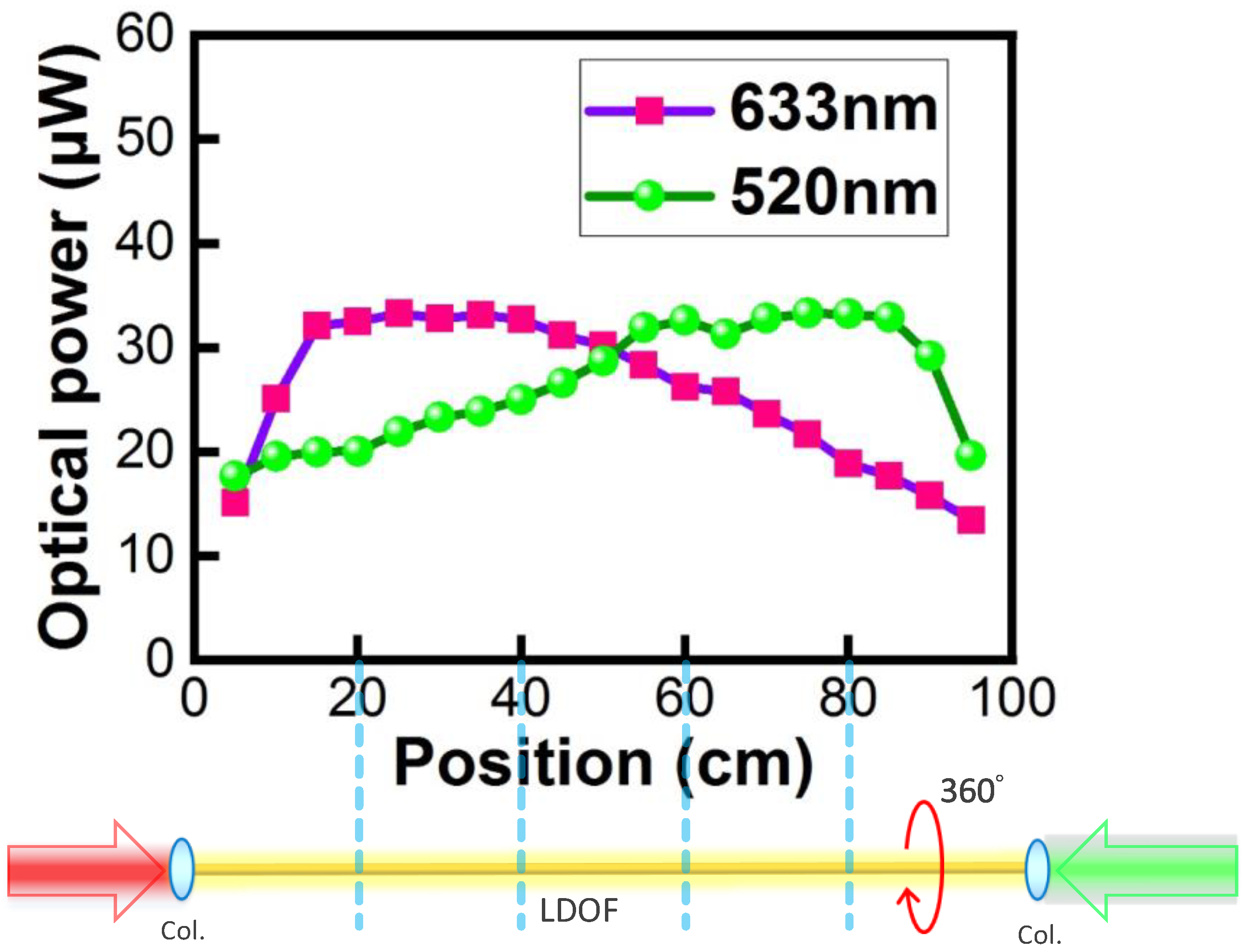
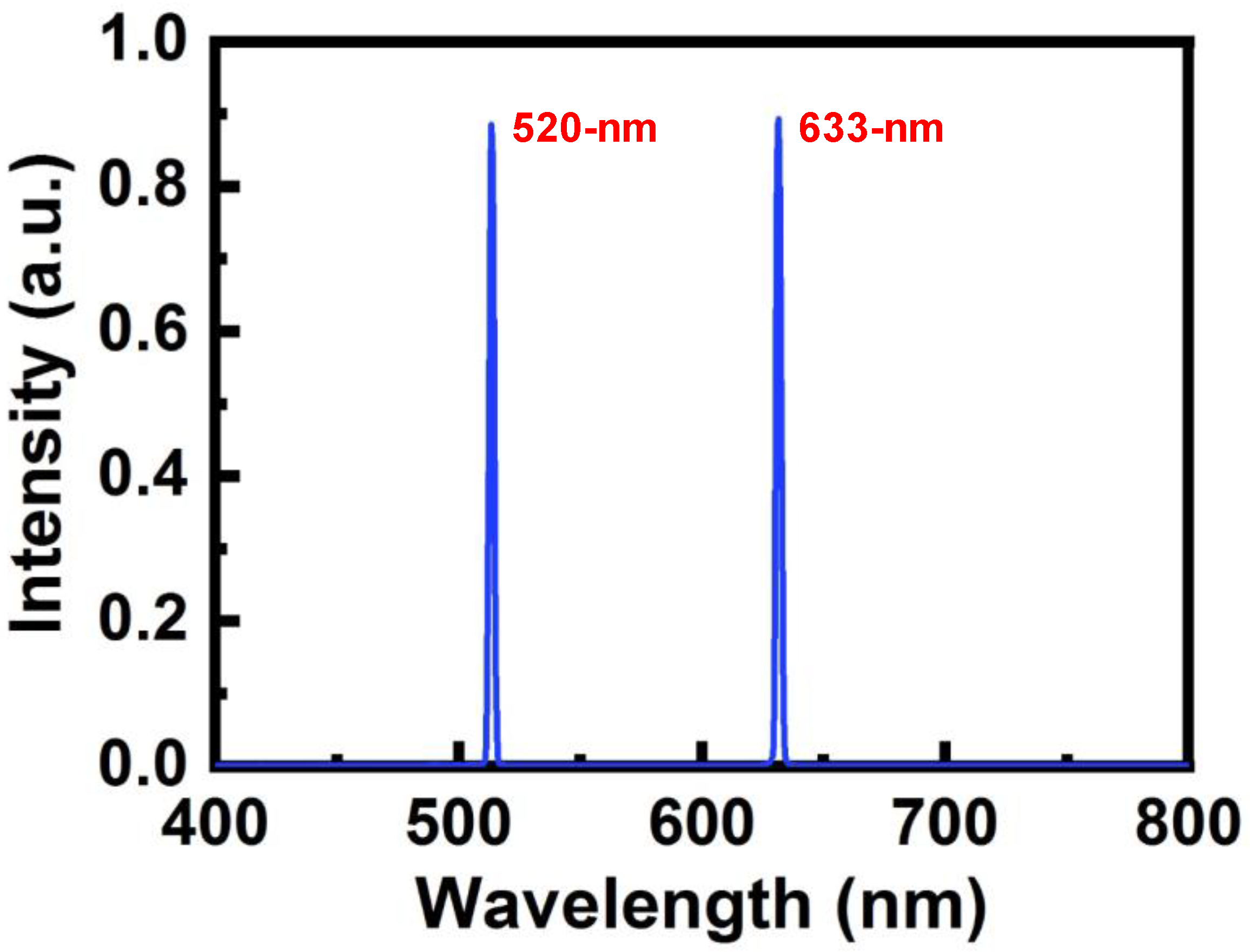
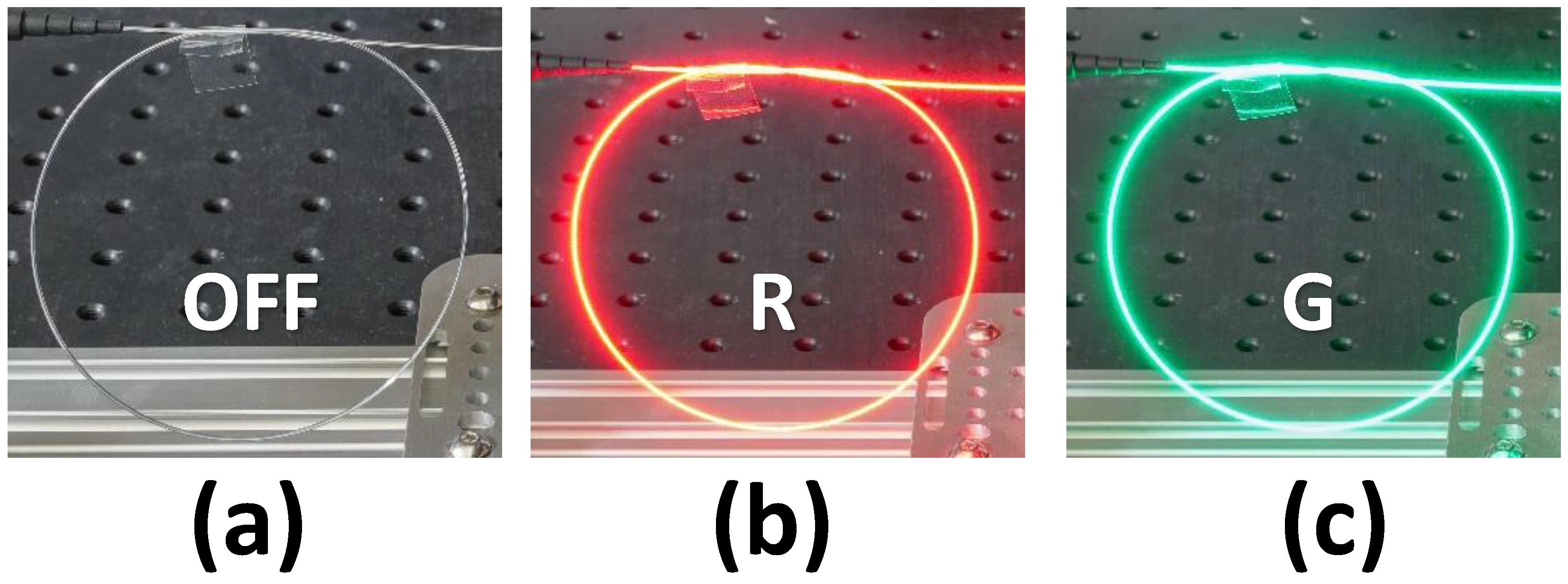
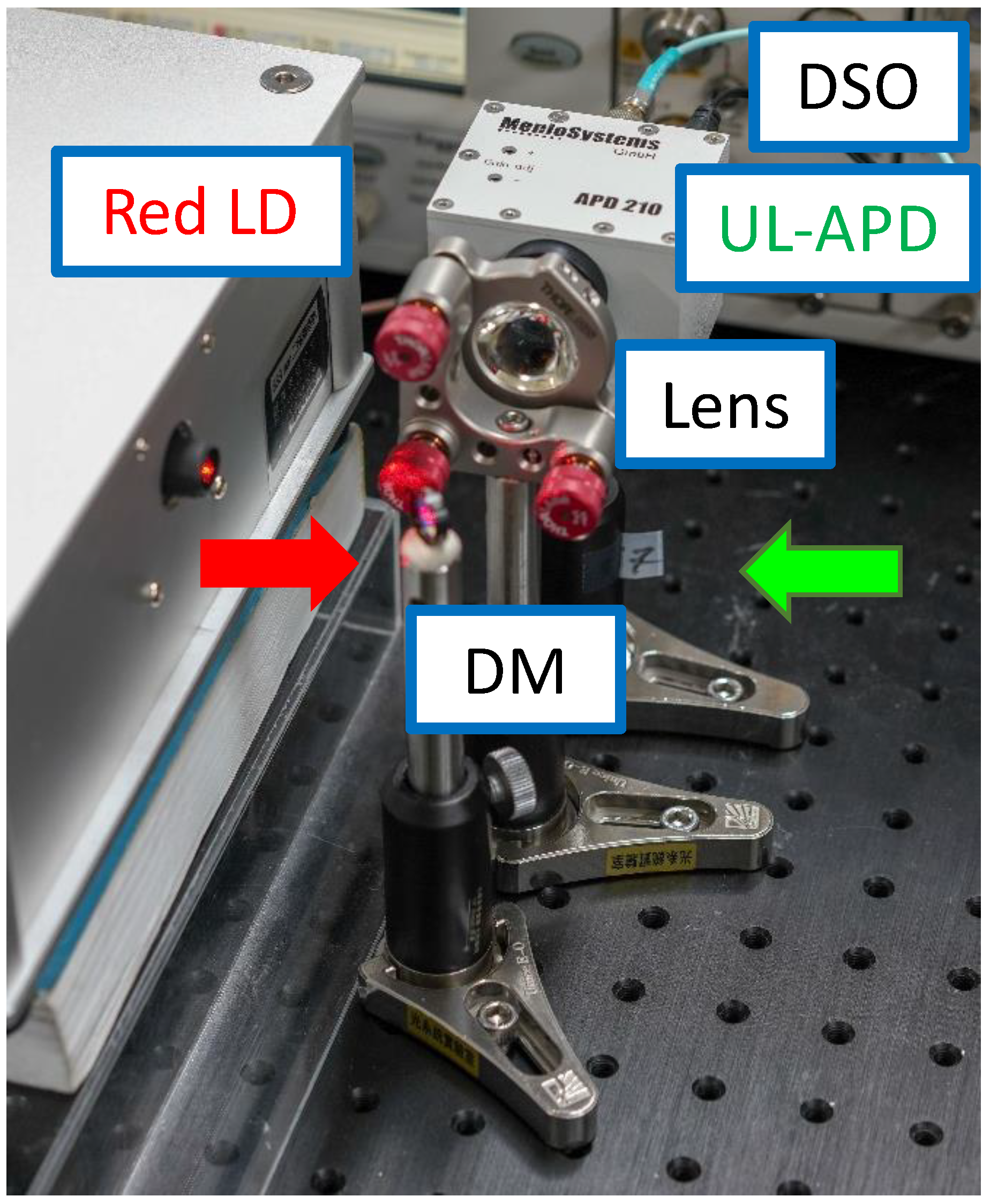
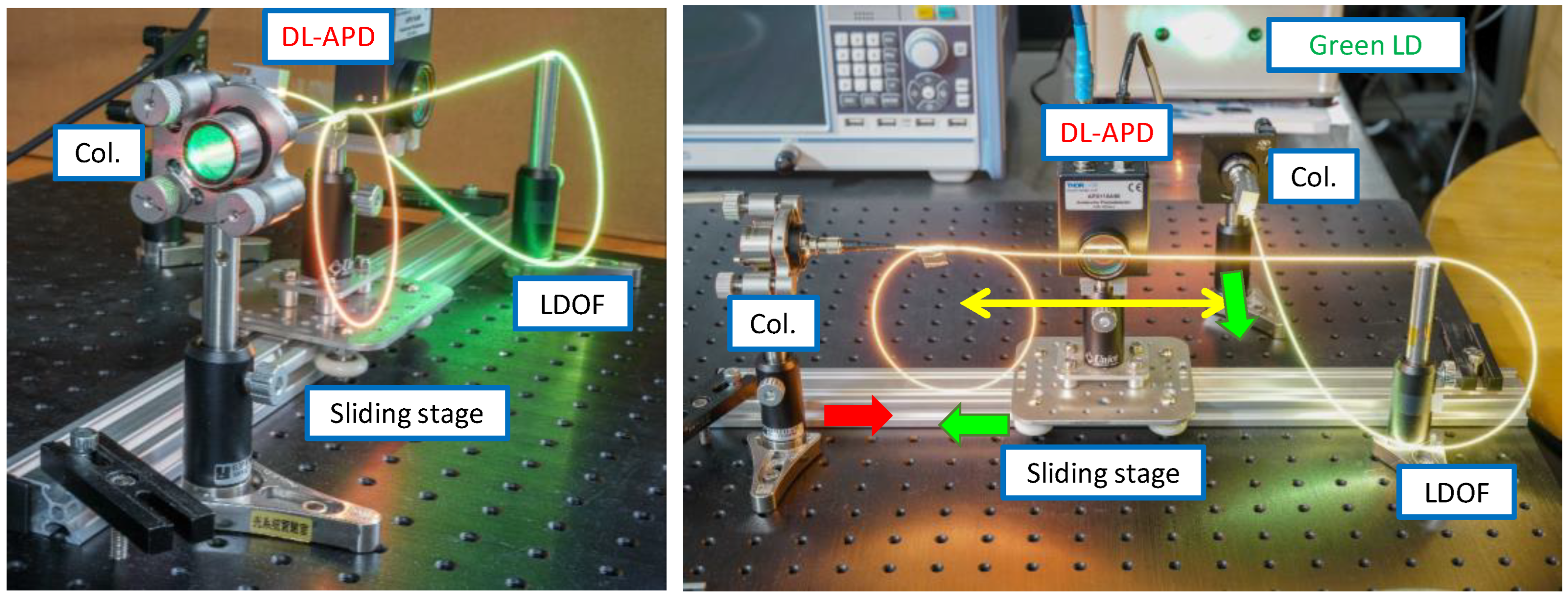
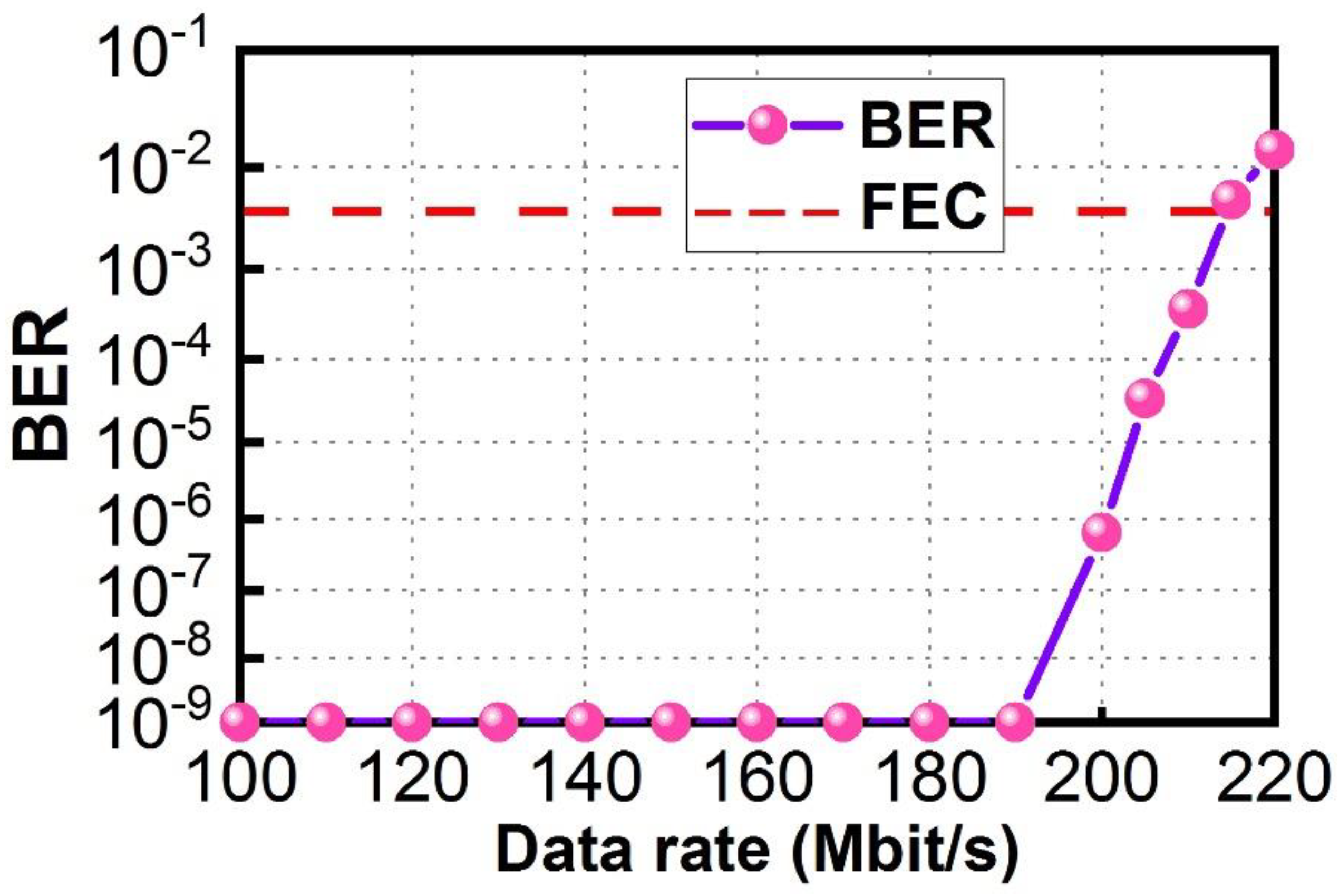
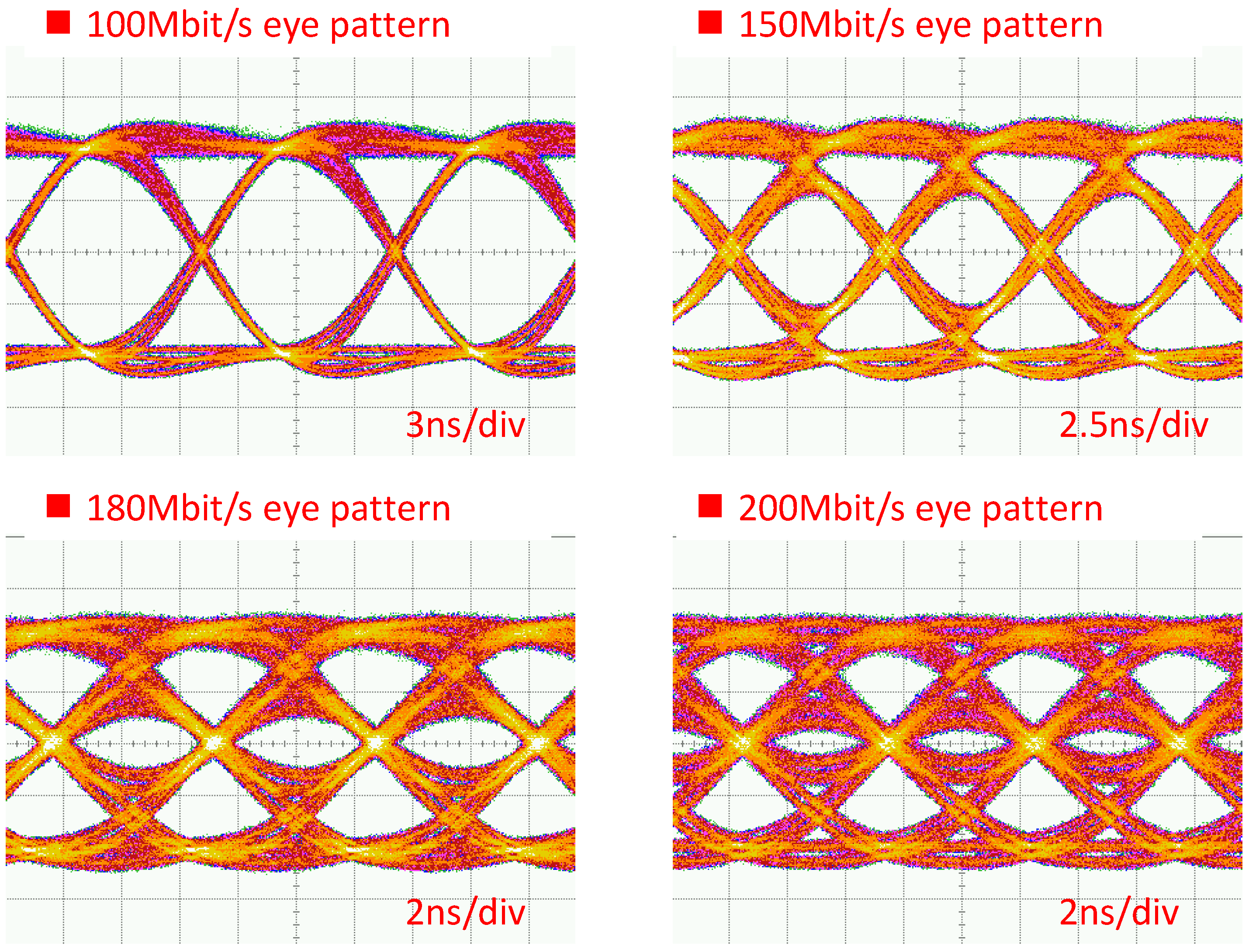
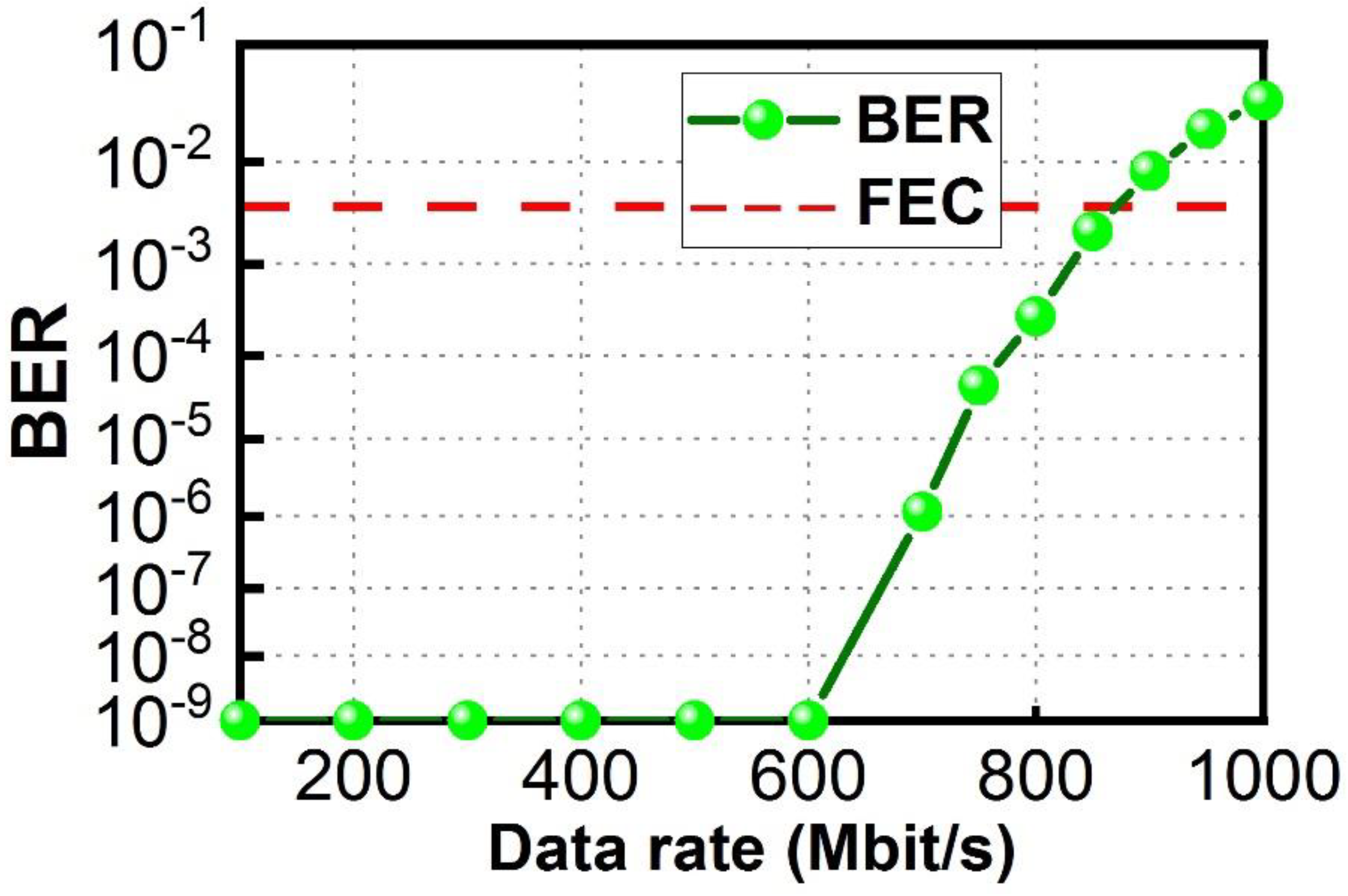
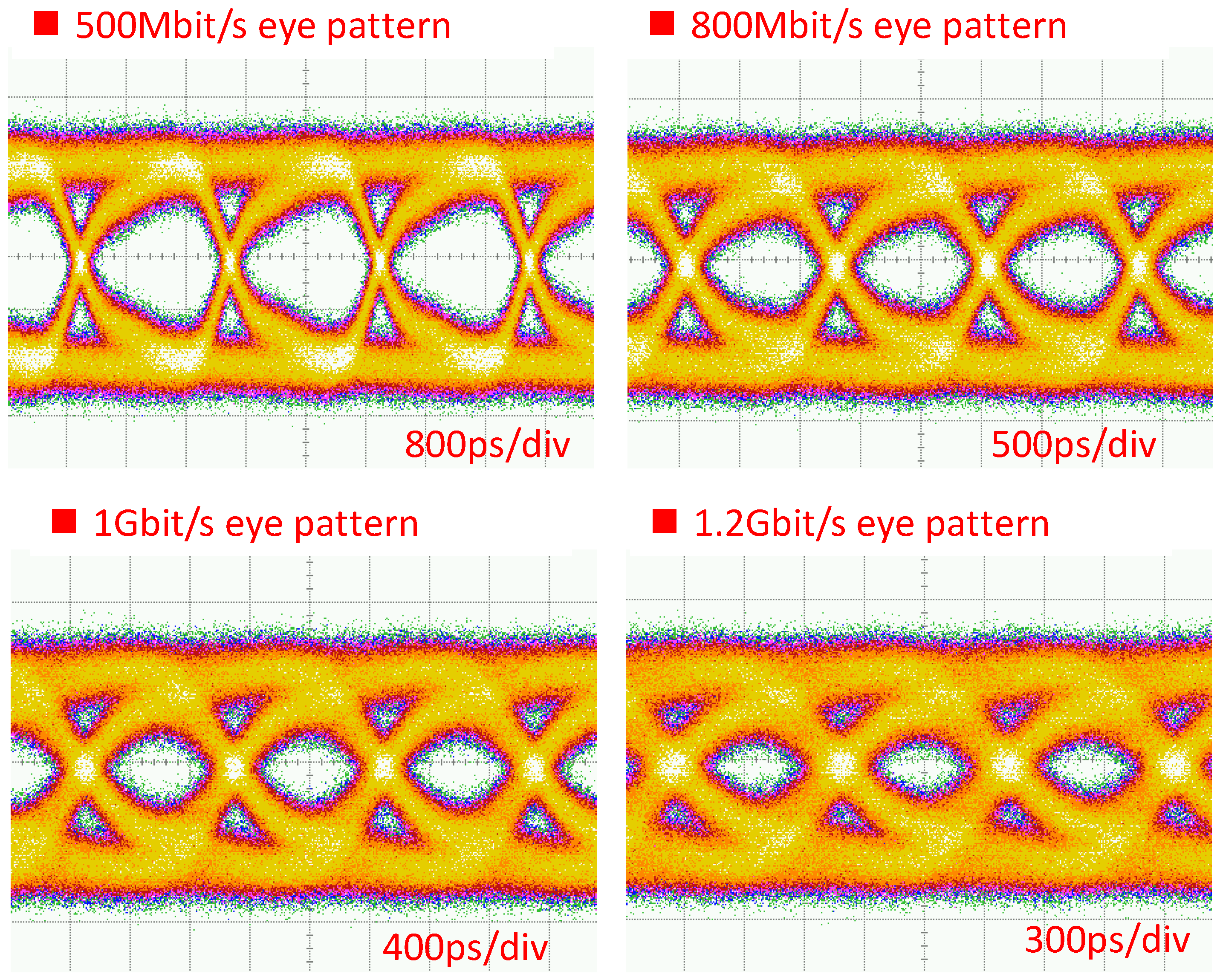
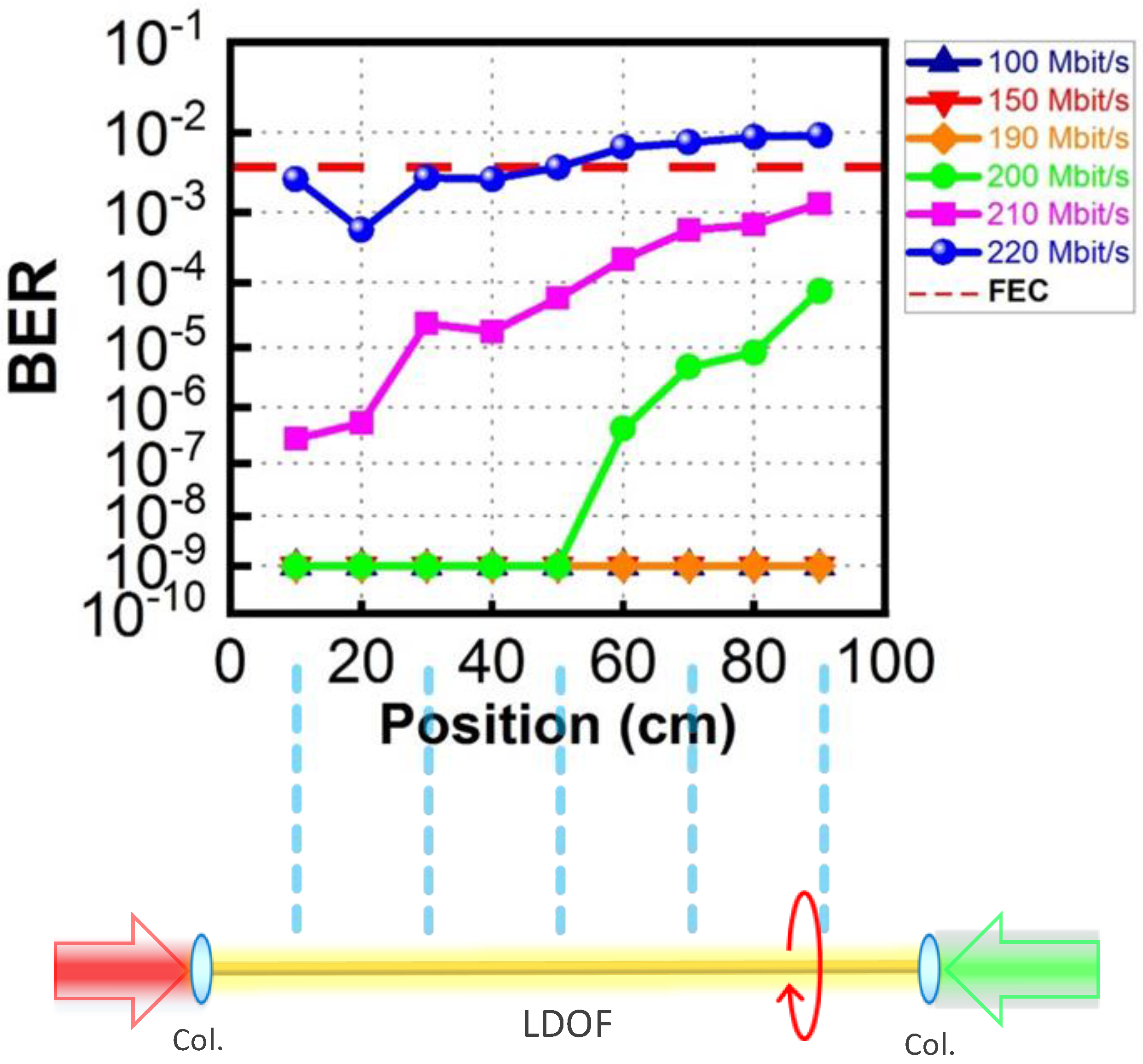
5. Conclusions
Author Contributions
Funding
Conflicts of Interest
References
- Elgala, H.; Mesleh, R.; Haas, H. Indoor optical wireless communication: Potential and state-of-the-art, IEEE Commun. Mag., 2011, 49, 56−62. [CrossRef]
- Haas, H.; Elmirghani, J.; White I. Optical wireless communication, Phil. Trans. R. Soc. A. 2020, 3782020005120200051.
- Chow, C. W.; Yeh, C. H.; Liu, Y.; Lai, Y.; Wei, L. Y.; Hsu, C. W.; Chen, G. H.; Liao, X. L.; Lin, K. H. Enabling techniques for optical wireless communication systems, Proc. OFC 2020, M2F.1. (Invited).
- Wang, K.; Song, T.; Wang, Y.; Fang, C.; Nirmalathas, A.; Lim, C.; Wong, E.; Kandeepan S. Evolution of short-range optical wireless communications, Proc. OFC 2022, paper Tu3C.4. [CrossRef]
- Wang, K.; Nirmalathas, A.; Lim, C.; Skafidas, E. High-speed indoor optical wireless communication system with single channel imaging receiver, Opt. Express 2012, 20, 8442–8456. [CrossRef]
- Chow, C. W.; Yeh, C. H.; Liu, Y.; Liu, Y. F. Digital signal processing for light emitting diode based visible light communication, IEEE Photon. Soc. Newslett. 2012, 26, 9–13.
- Minh, H. L.; O’Brien, D.; Faulkner, Zeng, L.; Lee, K.; Jung, D.; Oh, Y. J.; Won, E. T. 100-Mb/s NRZ visible light communications using a post-equalized white LED, IEEE Photon. Technol. Lett., 2009, 21, 1063–1065.
- Vučić, J.; Kottke, C.; Nerreter, S.; Langer, K. D.; Walewski, J. W. 513 Mbit/s visible light communications link based on DMT-modulation of a white LED, J. Lightw. Technol., 2010, 28, 3512–3518. [CrossRef]
- Chow, C. W.; Yeh, C. H.; Liu, Y. F.; Liu, Y. Improved modulation speed of LED visible light communication system integrated to main electricity network, Elect. Lett. 2011, 47, 867–868. [CrossRef]
- Lu, H. H.; Lin, Y. P.; Wu, P. Y.; Chen, C. Y.; Chen, M. C.; Jhang, T. W. A multiple-input-multiple-output visible light communication system based on VCSELs and spatial light modulators, Opt. Exp., 2014, 22, 3468–3474. [CrossRef]
- Haas, H. Visible Light Communication, Proc. OFC 2015, paper Tu2G.5.
- Li, C. Y.; Lu, H. H.; Tsai, W. S.; Feng, C. Y.; Chou, C. R.; Chen, Y. H.; Nainggolan, A. White-lighting and WDM-VLC system using transmission gratings and an engineered diffuser, Opt. Lett., 2020, 45, 6206–6209. [CrossRef]
- Wu, T. C.; Chi, Y. C.; Wang, H. Y.; Tsai, C. T.; Huang, Y. F.; Lin, G. R. Tricolor R/G/B laser diode based eye-safe white lighting communication beyond 8 Gbit/s, Sci. Rep., 2017, 7, 11. [CrossRef]
- Tsai, C. T.; Cheng, C. H.; Kuo, H. C.; Lin, G. R. Toward high-speed visible laser lighting based optical wireless communications," Progress in Quant. Electron., 2019, 67, 100225. [CrossRef]
- Yu, T.-C.; Huang, W.-T.; Lee, W.-B.; Chow, C.-W.; Chang, S.-W.; Kuo, H.-C. Visible Light Communication System Technology Review: Devices, Architectures, and Applications. Crystals 2021, 11, 1098. [CrossRef]
- Chi, N.; Zhou, Y.; Wei Y.; Hu, F. Visible light communication in 6G: Advances, challenges, and prospects, IEEE Vehicular Technol. Mag., 2020, 15, 93–102. [CrossRef]
- Niarchou, E.; Boucouvalas, A. C.; Ghassemlooy, Z.; Alves, L. N.; Zvanovec, S. Visible Light Communications for 6G Wireless Networks, Third South American Colloquium on Visible Light Communications (SACVLC), Toledo, Brazil, 2021, pp. 01–06. https://doi.org/10.1109/SACVLC53127.2021.9652231. [CrossRef]
- Shen, C.; Guo, Y.; Oubei, H. M.; Ng, T. K.; Liu, G.; Park, K. H.; Ho, K. T.; Alouini, M. -S.; Ooi, B. S. 20-meter underwater wireless optical communication link with 1.5 Gbps data rate, Opt. Exp., 2016, 24, 25502–25509.
- Shen, C.; Alkhazragi, O.; Sun, X.; Guo, Y.; Ng, T. K.; Ooi, B. S. Laser-based visible light communications and underwater wireless optical communications: A device perspective, Proc. SPIE, 10939, Novel In-Plane Semiconductor Lasers XVIII, 2019, 109390E.
- Li, C. Y.; Lu, H. H.; Huang, Y. C.; Huang, Q. P.; Xie, J. Y.; Tsai, S. E. 50 Gb/s PAM4 underwater wireless optical communication systems across the water–air–water interface [Invited], Chin. Opt. Lett. 2019 17, 100004. [CrossRef]
- Chen, L. K.; Shao, Y.; Di Y. Underwater and Water-Air Optical Wireless Communication, J. Lightwave Technol. 2022, 40, 1440–1452. [CrossRef]
- Cincotta, S.; Neild, A.; He, C.; Armstrong, J. Visible light positioning using an aperture and a quadrant photodiode, IEEE Globecom Workshops, 2017.
- Kim, H. S.; Kim, D. R.; Yang, S. H.; Son, Y. H.; Han, S. K. An indoor visible light communication positioning system using a RF carrier allocation technique, J. Lightw. Technol., 2013, 31, 134–144. [CrossRef]
- Guan, W.; Wu, Y.; Wen, S.; Chen, H.; Yang, C.; Chen, Y.; Zhang, Z. A novel three-dimensional indoor positioning algorithm design based on visible light communication, Opt. Commun., 2017, 392, 282–293. [CrossRef]
- Hsu, L.-S.; Chow, C.-W.; Liu, Y.; Yeh, C.-H. 3D Visible Light-Based Indoor Positioning System Using Two-Stage Neural Network (TSNN) and Received Intensity Selective Enhancement (RISE) to Alleviate Light Non-Overlap Zones. Sensors 2022, 22, 8817. https://doi.org/10.3390/s22228817. [CrossRef]
- Danakis, C.; Afgani, M.; Povey, G.; Underwood, I.; Haas, H. Using a CMOS camera sensor for visible light communication. Proc. OWC’12, 1244–1248.
- Luo, P.; Zhang, M.; Ghassemlooy, Z.; Minh, H. L.; Tsai, H. M.; Tang, X.; Png, L. C.; Han, D. Experimental demonstration of RGB LED-based optical camera communications, IEEE Photon. J., 2015, 7, 7904212. [CrossRef]
- Cahyadi, W.A.; Chung, Y.H.; Ghassemlooy, Z.; Hassan, N.B. Optical Camera Communications: Principles, Modulations, Potential and Challenges. Electronics 2020, 9, 1339. https://doi.org/10.3390/electronics9091339. [CrossRef]
- Chow, C. W.; Liu, Y.; Yeh, C. H.; Chang, Y. H.; Lin, Y. S.; Hsu, K. L.; Liao, X. L.; Lin, K. H. Display Light Panel and Rolling Shutter Image Sensor Based Optical Camera Communication (OCC) Using Frame-Averaging Background Removal and Neural Network, J. Lightwave Technol. 2021, 39, 4360–4366. [CrossRef]
- Singh, R.; Feng, F.; Hong, Y.; Faulkner, G.; Deshmukh, R.; Vercasson, G.; Bouchet, O.; Petropoulos, P.; O’Brien, D. Design and characterisation of terabit/s capable compact localisation and beam-steering terminals for fiber-wireless-fiber links, J. Lightw. Technol., 2020, 38, 6817–6826. [CrossRef]
- Wu, L.; Han, Y.; Li, Z.; Zhang, Y.; Fu, H. Y. 12 Gbit/s indoor optical wireless communication system with ultrafast beam-steering using tunable VCSEL, Opt. Exp., 2022, 30, 15049. [CrossRef]
- Oh, C. W.; Cao, Z.; Tangdiongga, E.; Koonen, T. Free-space transmission with passive 2D beam steering for multi-gigabit-per-second per-beam indoor optical wireless networks, Opt. Exp., 2016, 24, 19211. [CrossRef]
- Cao, Z.; Zhang, X.; Osnabrugge, G.; Li, J.; Vellekoop, I. M.; Koonen A. M. J.; Reconfigurable beam system for non-line-of-sight free-space optical communication. Light Sci Appl 2019, 8, 69. https://doi.org/10.1038/s41377-019-0177-3. [CrossRef]
- Chow, C. W.; Chang, Y. C.; Kuo, S. I.; Kuo, P. C.; Wang, J. W.; Jian, Y. H.; Ahmad, Z.; Fu, P. H.; Shi, J. W.; Huang, D. W.; Hung, T. Y.; Lin, Y. Z.; Yeh, C. H.; Liu, Y. Actively controllable beam steering optical wireless communication (OWC) using integrated optical phased array (OPA), J. Lightwave Technol., 2023, 41, 1122–1128. [CrossRef]
- Mulyawan, R.; Gomez, A.; Chun, H.; Rajbhandari, S.; Manousiadis, P. P.; Vithanage, D. A.; Faulkner, G.; Turnbull, G. A.; Samuel, I. D. W.; Collins, S.; O’Brien, D. A comparative study of optical concentrators for visible light communications," Proc. SPIE 10128, Broadband Access Communication Technologies XI, 101280L; https://doi.org/10.1117/12.2252355. [CrossRef]
- Peyronel, T.; Quirk, K. J.; Wang, S. C.; Tiecke, T. G. Luminescent detector for free-space optical communication, Optica, 2016, 3, 787–792. [CrossRef]
- Ishibashi, M.; Takizuka, H.; Haruyama, S.; Free-space optical communication system for industrial vehicles using two types of optical fibers, IEEE Globecom Workshops 2018, pp. 1–5.
- Kang, C. H.; Trichili, A.; Alkhazragi, O.; Zhang, H.; Subedi, R. C.; Guo, Y.; Mitra, S.; Shen, C.; Roqan, I. S.; Ng, T. K.; Alouini, M. S.; Ooi, B. S. Ultraviolet-to-blue color-converting scintillating-fibers photoreceiver for 375-nm laser-based underwater wireless optical communication, Opt. Exp., 2019, 27, 30450–30461. [CrossRef]
- Manousiadis, P. P.; Chun, H.; Rajbhandari, S.; Vithanage, D. A.; Mulyawan, R.; Faulkner, G.; Haas, H.; O’Brien, D. C.; Collins, S.; Turnbull, G. A.; Samuel, I. D. W. Optical antennas for wavelength division multiplexing in visible light communications beyond the Étendue limit, Adv. Opti. Mat., 2020, 8, 1901139. [CrossRef]
- Riaz, A.; Collins, S. A wide field of view VLC receiver for smartphones, Proc. ECOC, 2020. https://doi.org/10.1109/ECOC48923.2020.9333306. [CrossRef]
- Tsai, D. C.; Chang, Y. H.; Chow, C. W.; Liu, Y.; Yeh, C. H.; Peng, C. W.; Hsu, L. S. Optical camera communication (OCC) using a laser-diode coupled optical-diffusing fiber (ODF) and rolling shutter image sensor, Opt. Exp., 2022, 30, 16069–16077. [CrossRef]
- Logunov, S.; Fewkes, E.; Shustack, P.; Wagner, F. Light diffusing optical fiber for Illumination, Proc. Renewable Energy and the Environment, OSA Technical Digest, 2013, paper DT3E.4.
- Corning® Fibrance® Light-Diffusing Fiber Specification. https://www.corning.com/media/worldwide/csm/documents/Corning_Fibrance_Light_Diffusing_Fiber.pdf.
Disclaimer/Publisher’s Note: The statements, opinions and data contained in all publications are solely those of the individual author(s) and contributor(s) and not of MDPI and/or the editor(s). MDPI and/or the editor(s) disclaim responsibility for any injury to people or property resulting from any ideas, methods, instructions or products referred to in the content. |
© 2023 by the authors. Licensee MDPI, Basel, Switzerland. This article is an open access article distributed under the terms and conditions of the Creative Commons Attribution (CC BY) license (http://creativecommons.org/licenses/by/4.0/).





